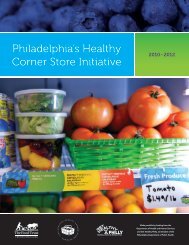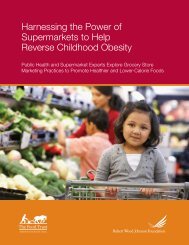The Grocery Gap: Who Has Access to Healthy - The Food Trust
The Grocery Gap: Who Has Access to Healthy - The Food Trust
The Grocery Gap: Who Has Access to Healthy - The Food Trust
You also want an ePaper? Increase the reach of your titles
YUMPU automatically turns print PDFs into web optimized ePapers that Google loves.
PolicyLink<strong>The</strong> <strong>Food</strong> <strong>Trust</strong>restaurants have significantly higher rates ofpremature death from diabetes.4. New and improved healthy food retailin underserved communities createsjobs and helps <strong>to</strong> revitalize low-incomeneighborhoods. Though the economicimpacts of food retailers are understudied,we know that grocery s<strong>to</strong>res contribute <strong>to</strong>community economic development. Analysisof a successful statewide public-privateinitiative <strong>to</strong> bring new or revitalized grocerys<strong>to</strong>res <strong>to</strong> underserved neighborhoods inPennsylvania provides positive evidence thatfresh food markets can create jobs, bolster localeconomies, and revitalize neighborhoods. <strong>The</strong>effort has created or retained 4,860 jobs in78 underserved urban and rural communitiesthroughout the state. Analyses of s<strong>to</strong>ressupported by the effort find they lead <strong>to</strong>increased economic activity in surroundingcommunities.Implications for Policy<strong>The</strong> evidence is clear that many communities—predominantly low-income, urban communitiesof color and rural areas—lack adequate access <strong>to</strong>healthy food, and the evidence also suggests thatthe lack of access negatively impacts the healthof residents and neighborhoods. <strong>The</strong>se findingsindicate that policy interventions <strong>to</strong> increaseaccess <strong>to</strong> healthy food in “food deserts” willhelp people eat a healthy diet, while contributing<strong>to</strong> community economic development.For many years, impacted communities andtheir advocates have been implementinga variety of strategies <strong>to</strong> increase access <strong>to</strong>fresh, wholesome foods, including:• Attracting or developing grocerys<strong>to</strong>res and supermarkets;• Developing other retail outlets suchas farmers’ markets, public markets,cooperatives, farmstands, communitysupportedagriculture programs, andmobile vendors (and ensuring publicbenefits can be used at these venues);• Increasing the s<strong>to</strong>ck of fruits, vegetables,and other healthy foods at neighborhoodcorner s<strong>to</strong>res or small groceries;• Growing food locally through backyardand community gardens and largerscaleurban agriculture; and• Improving transportation <strong>to</strong> grocerys<strong>to</strong>res and farmers’ markets.Improving access <strong>to</strong> healthy food is a criticalcomponent of an agenda <strong>to</strong> build an equitableand sustainable food system. It is time fora nationwide focus <strong>to</strong> ensure that healthyfood choices are available <strong>to</strong> all, buildingon these local efforts and innovations.Smart public policies and programs should supportcommunities in their efforts <strong>to</strong> develop, implement,and test strategies that increase healthy foodaccess. Government agencies at the local, state,and federal level should prioritize the issue ofinequitable food access in low-income, underservedareas. Programs and policies that are workingshould be expanded and new programs shouldbe developed <strong>to</strong> bring more grocery s<strong>to</strong>res andother fresh food retail outlets <strong>to</strong> neighborhoodswithout access <strong>to</strong> healthy foods. Transportationbarriers <strong>to</strong> fresh food outlets should be addressed.Whenever possible, policies <strong>to</strong> address fooddeserts should link with comprehensive efforts <strong>to</strong>build strong regional food and farm systems.Residents of low-income communities andcommunities of color in urban and rural areashave suffered for <strong>to</strong>o long from a lack ofaccess <strong>to</strong> healthy food. With local and stateprograms showing enormous promise, now isthe time for policymakers <strong>to</strong> enact policies thatwill catalyze the replication of local and stateinnovations and bring them <strong>to</strong> a national scale.9






